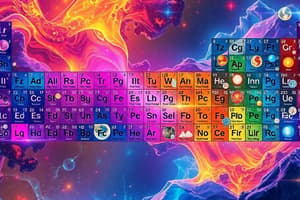Podcast
Questions and Answers
Which property do metalloids share with nonmetals?
Which property do metalloids share with nonmetals?
- Both can react to form acidic compounds. (correct)
- Both are brittle. (correct)
The metalloid that has three valence electrons is ___________.
The metalloid that has three valence electrons is ___________.
Boron
Which properties are characteristic of metalloids?
Which properties are characteristic of metalloids?
- Intermediate conductivity and a high melting point. (correct)
- High conductivity and a low melting point.
- Low conductivity and a high melting point.
- They do not conduct electricity.
Which lists only metalloids?
Which lists only metalloids?
How does the number of valence electrons in atoms of metalloids explain why metalloids are semiconductors?
How does the number of valence electrons in atoms of metalloids explain why metalloids are semiconductors?
Which element in period 3 on the periodic table is a metalloid?
Which element in period 3 on the periodic table is a metalloid?
The atoms of a metalloid have 6 valence electrons. The metalloid is used as a semiconductor. Which best describes the electron shell in which the valence electrons are located?
The atoms of a metalloid have 6 valence electrons. The metalloid is used as a semiconductor. Which best describes the electron shell in which the valence electrons are located?
Where should Brenda place the property that some elements can react to form basic compounds in her notes?
Where should Brenda place the property that some elements can react to form basic compounds in her notes?
What material is most likely used in solar panels, and why?
What material is most likely used in solar panels, and why?
Which lists the elements in order from most conductive to least conductive?
Which lists the elements in order from most conductive to least conductive?
Which statements describe properties that are unique to metalloids? Check all that apply.
Which statements describe properties that are unique to metalloids? Check all that apply.
Which element is a metalloid? Check all that apply.
Which element is a metalloid? Check all that apply.
Which lists the elements in order from least conductive to most conductive?
Which lists the elements in order from least conductive to most conductive?
Why might an engineer want to use a metalloid when designing a new computer processor?
Why might an engineer want to use a metalloid when designing a new computer processor?
Flashcards are hidden until you start studying
Study Notes
Properties of Metalloids
- Metalloids share properties with nonmetals, such as the ability to react to form acidic compounds.
- Characteristic properties include intermediate conductivity and high melting points.
- Metalloids are defined by their brittleness.
Valence Electrons in Metalloids
- Boron has three valence electrons, making it an important metalloid.
- Most metalloids possess between three to six valence electrons, allowing them to either lose or gain electrons, which contributes to their semiconductor properties.
Metalloids in the Periodic Table
- Silicon (Si) is the only metalloid present in period 3 of the periodic table.
- Common metalloids include boron (B), germanium (Ge), and tellurium (Te).
Electron Configuration
- The electron shell of metalloids should ideally be small, facilitating the gaining of electrons.
Application of Metalloids
- A metalloid is typically used in solar panels due to its semiconductor properties, which enhance conductivity in the presence of light.
Conductivity of Elements
- Elements can be ordered by conductivity, with potassium (K) being the most conductive, followed by germanium (Ge), and selenium (Se).
Unique Characteristics of Metalloids
- Unique properties of metalloids include their shiny appearance, semiconductive behavior, and brittleness.
Metalloid Identifiers
- Examples of metalloids include silicon (Si) and antimony (Sb).
- Polonium (Po) is NOT considered a metalloid.
Conductivity Order
- Elements can also be arranged from least to most conductive, for instance, nitrogen (N) is the least conductive, followed by antimony (Sb), then bismuth (Bi).
Utilization in Technology
- Engineers prefer using metalloids in the design of computer processors due to their ability to control electric current effectively.
Studying That Suits You
Use AI to generate personalized quizzes and flashcards to suit your learning preferences.




